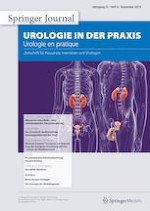12.11.2019 | Originalien
Minimal-invasive Therapien zur Behandlung des benignen Prostatasyndroms – besser als Medikamente?
Erschienen in: Urologie in der Praxis | Ausgabe 4/2019
Einloggen, um Zugang zu erhaltenZusammenfassung
Das benigne Prostatasyndrom (BPS) stellt eine der häufigsten Erkrankungen beim alternden Mann dar und ist mit einer hohen ökonomischen Belastung assoziiert. Die pharmakologische Behandlung stellt die empfohlene Erstlinientherapie dar, wurde zuletzt aufgrund ihres Nebenwirkungsprofils jedoch zunehmend kritisch hinterfragt. Minimal-invasive Therapien (MIT) zur Behandlung des BPS wurden traditionell mit etablierten transurethralen Operationsverfahren verglichen. Hierbei zeigte sich stets eine unterlegene Effektivität, bei jedoch deutlich günstigerem Sicherheitsprofil. Somit stellt sich die Frage, ob MIT anstelle von Medikamenten als Erstlinientherapie des BPS zum Einsatz kommen sollten.
Bislang existieren jedoch keine komparativen Studien, welche aktuell verwendete MIT mit der Pharmakotherapie vergleichen. Eine randomisierte Studie mit dem Vergleich von α‑Blockern und der mittlerweile überholten transurethralen Mikrowellenthermotherapie (TUMT) sowie indirekte Vergleichsstudien weisen auf günstige funktionelle und wirtschaftliche Voraussetzungen der MIT als Erstlinientherapie hin. Insgesamt existiert jedoch keine ausreichende Evidenz, um MIT in dieser Rolle im klinischen Alltag zu verwenden.
So sollten MIT aktuell nur bei Patienten eingesetzt werden, die sich nach gründlicher Aufklärung gegen eine Medikamententherapie entscheiden oder bei denen eine solche nicht möglich ist. Auch in diesem Fall gilt es, die unterschiedliche Evidenz der einzelnen MIT und die daraus resultierenden Empfehlungen in den Leitlinien zu beachten.
Anzeige
